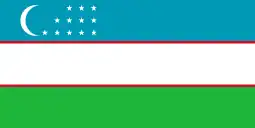| Langarota Mosque | |
|---|---|
Uzbek: Langarota masjidi | |
| Religion | |
| Affiliation | Islam |
| Location | |
| Location | Qashqadaryo, Uzbekistan |
| Geographic coordinates | 38°40′54.038″N 66°45′29.205″E / 38.68167722°N 66.75811250°E |
| Architecture | |
| Type | Mosque |
| Style | Islamic architecture |
| Completed | 1448 |
The Langarota Mosque is an architectural monument located in the village of Katta Langar in the Qashqadaryo region, dating back to the first half of the 16th century. The mosque is typical of the mountainous regions of Central Asia and consists of two rooms and a veranda at the entrance.
History
According to historical sources, this mosque, popularly known as "Khazrat Langar Ota", was built in the year 1448 by a man named Abul Hasan Sheikh. The construction of the mosque was carried out with the support of charitable organizations and patrons.[1] According to some accounts, Abul Hasan initiated this project after receiving a letter from his elder in Bukhara.
Location
The Langar Ota Mosque is situated on a hill in the village of Langar in the Qamashi district. The village is located between the Hissar mountain range, approximately 25-30 kilometers from the village of Kyzyltepa.[2]
Architecture
The mosque features a veranda, four mihrabs, two prayer rooms, seven doors, and nineteen columns. There are speculations that the initially constructed mosque was small and later expanded. Consequently, the two prayer rooms are referred to as the large and small mosques.
On the veranda, two rows of tall carved columns are positioned. The ceiling is adorned in a traditional style, with beams and timbers intricately painted with floral motifs, supported by four columns in the small prayer room and five columns in the large prayer room. The small prayer room is very old, with thick walls. Later, a large room and a shared terrace were built adjacent to it.
The height of the mosque is 11 meters, with a total area of 32x32 meters.
The altar is adorned with inscriptions written in the thuluth script. The decorative inscriptions contain dates from 1519-1520, 1562-1563, 1748, and 1807-1808 (dates of construction and reconstruction). Tiles are arranged along the walls in a mosaic style, some polished with inscriptions in Arabic and an unknown language. The splendor of the decoration in the large room lies in the colors of the tiles. The embellishments of the altar and the walls are well-preserved. Yellow and orange tile fragments with blue, orange, and white borders are affixed to the black ground in panel lines. The surfaces of the motifs are adorned with three different patterns of stars and dark "eights," while the center is embellished with gold paint. The lower part is separated from the main floor by smooth borders of gray marble, gilded.
The mosque's exquisite craftsmanship is also evident in the carved lattices of gypsum on its windows, columns, marble columns, and capitals.
Langarota Mausoleum
The monuments in the Langarota Mausoleum were built in the late 15th to mid-16th centuries. Sagas about influential Langarota sheikhs Muhammad Sadiq (1465-1545), Abul Hasan (1491-1592), and others have been preserved, as well as sagas about Timurid princesses and their compositions.
The mausoleum (total area 140x12.5 meters) is single-roomed (total area 5.2x5.2 meters) with a vaulted roof, resting on a four-intersecting dome. Shield-shaped arches are latticed, shelves are adorned with motifs of carved capitals, and the arches feature two-layered polychrome carving. Bricks were laid in "bandak" and "mavdj" styles on the surface of the mausoleum.[3]
Reconstruction
Judging by the inscriptions on the upper part of the column in the main hall of the mosque, it was reconstructed by the master Muhammadiyar in the year 1362 according to the Higri calendar (1905 AD).[4]
During the Soviet Union era, authorities conducted a series of reconstruction works on this territory.[5]
Today, a facsimile copy of the Katta Langar Quran, a famous instance of the Holy Quran written in Kufic script, is preserved in this mosque.
References
- ↑ "Qashqadaryo viloyati". uzbekistan.travel.uz. Retrieved 2023-08-24.
- ↑ "Langar ota masjidi haqida eshitganmisiz?". vaqf.uz. Retrieved 2023-08-24.
- ↑ “O’zbekiston milliy ensiklopediyasi”. Birinchi jild. Toshkent - 2000 y. (National Encyclopedia of Uzbekistan. The first volume. Tashkent. 2000)
- ↑ "Langar ota masjidi haqida eshitganmisiz?". sammuslim.uz. Retrieved 2023-08-24.
- ↑ "Langar-Ota". meros.uz. Retrieved 2023-08-24.
_(5658826884).jpg.webp)

.jpg.webp)